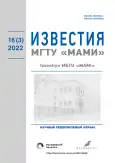Prerequisites for the creation of domestic onboard diagnostics tools for the M1 and M2 categories vehicles
- Authors: Zavoykin V.A.1
-
Affiliations:
- Central Scientific Research Automobile and Automotive Engines Institute (“NAMI”)
- Issue: Vol 16, No 3 (2022)
- Pages: 235-240
- Section: Transport and transport-technological facilities
- URL: https://journals.rcsi.science/2074-0530/article/view/126630
- DOI: https://doi.org/10.17816/2074-0530-108512
- ID: 126630
Cite item
Full Text
Abstract
BACKGROUND: Due to the steady growth of the worldwide fleet of vehicles alongside the sophistication of their operational functions and the increase in the number and manufacturability of electronic control units, used in a vehicle, the demand for means of access to the performance of on-board electronic sys-tems at the final stages of their production and operation is increasing. This review is necessary to summarize the available data from the world experience in the development and implementation of on-board diagnostic systems.
AIMS: Formulation of general principles for the development of on–board diagnostic systems, helpful to outline reasonable technical solutions for the task of creation of proprietary domestic diagnostic environment for vehicles.
METHODS: This paper describes the purpose and role of onboard diagnostic systems used in world practice for modern vehicles. Classes of diagnostic devices are allocated according to the level of implemented functions. The grounds that determine the demand for development of proprietary onboard diagnostic systems for wheeled vehicles are considered. A review of the functionality of the original diagnostic tools of foreign vehicle manufacturers was carried out. The main requirements imposed on developers by the ISO 27145 and ISO 14229 group of standards within the framework of the implementation of modern diagnostic systems in domestic vehicles of the M1 and M2 categories are determined.
RESULTS: A specific set of functions recommended for integration into diagnostic equipment being developed as a part of promising domestic developments has been determined. The content of the positive effect of the practical implementation of the measures proposed according to the results of the analysis is formulated.
CONCLUSIONS: The performed scientific analysis of the features of the existing diagnostic equipment is helpful to determine the relevant trends in the implementation of a fundamentally new trend in on-board diagnostics in the Russian Federation, which contributes to increasing the level of competence of domestic specialists and development within the framework of the domestic engineering development strategy.
Full Text
##article.viewOnOriginalSite##About the authors
Vladislav A. Zavoykin
Central Scientific Research Automobile and Automotive Engines Institute (“NAMI”)
Author for correspondence.
Email: vlad.zavoykin@nami.ru
ORCID iD: 0000-0002-2624-9280
SPIN-code: 7703-0195
engineer, post graduate
Russian Federation, 2 Avtomotornaya street, 125438, MoscowReferences
- Santini A. OBD-II: Functions, Monitors and Diagnostic Techniques. Delmar: Delmar Cengage Learning; 2010.
- Petrovsky SV, Kozlovsky VN, Kritsky AV, et al. On-Board Intelligent Information System for Diagnosing Faults in the Ignition System of a Passenger Car. 2021 Intelligent Technologies and Electronic Devices in Vehicle and Road Transport Complex, TIRVED 2021 – Conference Proceedings. Moscow: IEEE; 2021. doi: 10.1109/TIRVED53476.2021.9639141
- Kozlovskiy VN, Petrovskiy SV, Novikova AP. Intelligent information system for diagnosing the state of autonomous transport objects. Fundamentalnye issledovaniya. 2016;6–1:73–77. (in Russ).
- Sergeev DV, Levkin IV. Development of a distributed information-advising system for diagnostics and vehicle control. Vestnik altayskoy nauki. 2010;2:20–26. (in Russ).
- ISO 27145-1:2012 Road vehicles – Implementation of World-Wide Harmonized On-Board Diagnostics (WWH-OBD) communication requirements – Part 1: General information and use case definition.
- OEM tools. https://oemtools.com [internet] (accessed: 04.04.2022).
- ISO 15765-3:2004 Road vehicles – Diagnostics on Controller Area Networks (CAN) – Part 3: Implementation of unified diagnostic services (UDS on CAN).
- ISO 14229-1:2020 Road vehicles – Unified diagnostic services (UDS) – Part 1: Application layer.
Supplementary files







